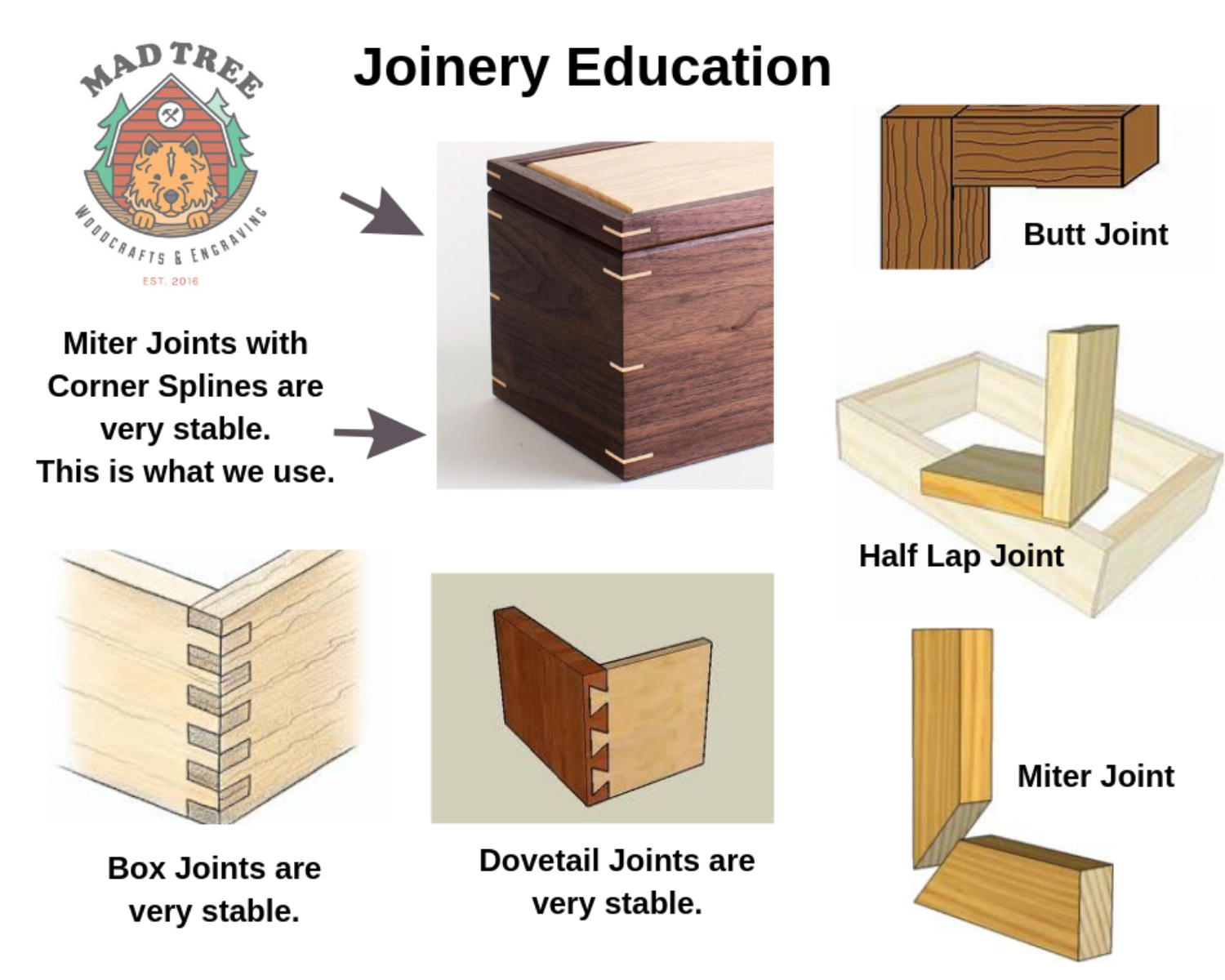Joinery—the way two pieces of wood are connected—determines a box’s strength, durability, and appearance. At Mad Tree Woodcrafts®, we handcraft heirloom keepsake boxes and choose miter joints reinforced with corner splines for their unmatched blend of longevity and clean, timeless lines.
What Is Wood Joinery?
Wood joinery is the craft of joining boards to create something new. Critical characteristics include strength (resistance to racking and pulling apart), toughness (shock resistance), longevity (how the joint ages), and appearance. Different joints trade off these qualities—and the time and skill required to make them.
Why We Prefer Miter Joints with Corner Splines
- Exceptional strength: The 45° miter maximizes glue surface; the added corner spline acts like a hardwood “key” that locks both sides together.
- Built for real life: Reinforced miters resist racking and shock better than plain miters. If a box is dropped, splines help prevent the corners from bursting apart.
- Heirloom finish: Miters hide end grain for a sleek, furniture-grade look that suits our signature design.
- Design accent: We use contrasting hardwood splines—both a structural upgrade and a subtle visual detail.
How Corner Splines Work
After cutting the mitered box, we slot each corner and inlay a spline—typically a contrasting hardwood. This mechanically reinforces the joint, increases long-grain glue bond, and keeps the corner stable over time.
Joinery Comparison at a Glance
| Joint Type | Strength & Durability | Appearance | Notes |
|---|---|---|---|
| Miter w/ Corner Splines | Excellent; resists racking and shock | Clean, seamless faces; decorative splines | Our preferred method for keepsake boxes |
| Dovetail | Excellent mechanical interlock | Visible pins/tails; traditional look | Great for drawers and casework |
| Box (Finger) Joint | Very good; lots of glue surface | Geometric finger pattern | Strong, but more utilitarian aesthetic |
| Plain Miter (no splines) | Fair; can fail under shock | Clean look | Not recommended for heirloom pieces |
| Butt / Half-Lap | Low–moderate (butt); moderate (half-lap) | Exposed end grain (butt) | Faster to make; lower price point |
When Other Joints Make Sense
Dovetails and box joints are excellent in the right context. We occasionally use them where their look or geometry fits the design. For our keepsake boxes, reinforced miters deliver the refined aesthetic our customers love—without sacrificing strength.
How to Judge Quality at a Glance
- Tight, gap-free corners: seams should be crisp and flush.
- Consistent grain flow: boards selected to wrap around the case.
- Reinforcement: look for splines, not just glue.
- Protective finish: durable topcoat applied evenly (we use premium multi-coat finishes).
See the Craftsmanship
Explore our handmade keepsake boxes, and browse real-world engraving examples. Learn more about us and how we collaborate on personalization—proofs included, engraving always free.
FAQ: Joinery & Durability
Will corner splines show?
Yes—intentionally. They’re a subtle, beautiful detail that also reinforces the joint.
Are reinforced miters as strong as dovetails?
For a keepsake box format, reinforced miters provide comparable real-world durability with a cleaner, end-grain-free look.
Can you repair a damaged corner?
Often, yes. Splines help prevent catastrophic failure, and minor damage can usually be repaired.
We design for generations. If you have questions about materials, joinery, or personalization, contact us—we’re happy to help.
